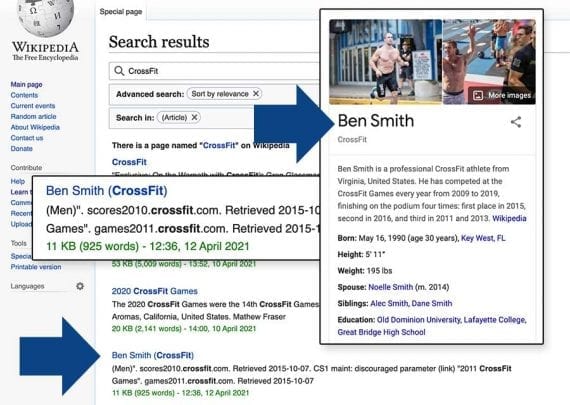Wikipedia can be helpful for content marketing, link building, and entity research, helping marketers reach an audience of potential customers.
To be clear, since at least 2007, all external links from Wikipedia include the nofollow attribute, directing search engines not to count the links in page-ranking algorithms.

All external links from Wikipedia articles have included the nofollow attribute since at least 2007. Thus no link authority is passed to Google.
This is something John Mueller, a senior webmaster trends analyst at Google, noted in a Reddit post, saying “randomly dropping a link into Wikipedia has no SEO value and will do nothing for your site,” according to an SEO Roundtable article.
It does not mean, however, that Wikipedia has no value for content marketers and search engine optimizers.
At the very least, Wikipedia helps with topic discovery, link building research, search-engine-optimization entity identification, and, perhaps, entity creation.
Topic Discovery
Using Wikipedia, marketers can identify potential content topics in a fashion similar to broken link building, according to Nate Shivar, an internet publisher.
The first step is to look in Wikipedia for broken links (“dead” in the Wikipedia vernacular) or for statements that need citation.
Here’s an example. Imagine that you are responsible for content marketing at an online store that sells science fiction collectibles. You want to create content to attract Star Trek fans, so you conduct the following search on Google.
site:wikipedia.org star trek intext:“dead link”
This search returns Wikipedia articles that mention Start Trek and include the phrase “dead link” somewhere in the content.
At the time of writing, the results for this query included the Wikipedia articles for two Star Trek Enterprise episodes. In each case, the dead link pointed to an article on the Radio Times website. For example, here is the broken link from the article for a Star Trek Enterprise episode titled “Anomaly.”
http://www.radiotimes.com/episode/xb5v/star-trek-enterprise--series-3---2-anomaly
Using the Internet Archive’s Wayback Machine, we can see what information was on this Radio Times page.

The Internet Archive has screen captures of websites over time even after pages are no longer live.
This content might inspire you to write articles about the Star Trek Enterprise series. Once you’re done, you could go back to Wikipedia, update the link, and improve the page.
You could also have found this broken link using Wikipedia’s monthly list of broken links.
https://en.wikipedia.org/w/index.php?title=Category:Articles_with_dead_external_links_from_March_2021
Just replace the month and year (“March_2021”) in the URL with the month you want to review.
Finally, we could conduct a similar search on Google for Wikipedia articles that need citations.
site:wikipedia.org star trek intext:“citation needed”
Link Building Research
Let’s assume you completed your article about the Star Trek Enterprise episode “Anomaly” and added the link to Wikipedia.
You could take that same broken link from Radio Times and check it for backlinks with Ahrefs, Semrush, or similar tools.

Dead links on Wikipedia might exist on other sites, too.
Entity Identification
In the SEO context, entities are the people, places, things, organizations, and concepts contained in a knowledge graph, a description or map of related entities.
Search engines sometimes rely on entities, as opposed to keywords, to better understand queries.
Here’s a basic introduction, below, of SEO entities from my CommerceCo by Practical Ecommerce presentation.
Some SEO professionals believe Wikipedia’s articles and application programming interface help identify entities that search engines such as Google are likely to recognize. And using entities in content could impact how well a given page ranks.
Imagine you are the marketer at a direct-to-consumer workout apparel brand. You want to create content about CrossFit that includes related entities.
You search Wikipedia for individual CrossFit Games and CrossFit athletes, such as Ben Smith, Samantha Briggs, and Tia-Clair Toomey, and for the concept of “overtraining.”
Many of the articles returned from the Wikipedia search represent an entity that Google recognizes. In this case, Ben Smith has a knowledge panel on Google and a Wikipedia article. Thus, for Google the person Ben Smith is an entity.

Many of the articles returned from a Wikipedia search represent an entity that Google recognizes. In this example, Ben Smith has a knowledge panel on Google and a Wikipedia article. Thus, the person Ben Smith is an entity Google recognizes.
It is also possible to use Wikipedia’s API to generate a similar list, according to digital marketer Daniel Heredia, who published an article on the topic, “Using Wikipedia API with Python for SEO.”
Entity Creation
Lastly, you might create Wikipedia articles, which could make their way into Google’s Knowledge Graph.
To be sure, creating a Wikipedia page is a challenge. The topic must meet several criteria. For example, Ahrefs, one of the most popular SEO and content marketing tools, does not have its own Wikipedia page.
Michal Pecánek, a marketer and content writer at Ahrefs, has an excellent guide to creating Wikipedia pages that mentions how his own efforts to create a Wikipedia article for the company failed.
If you cannot create an article about your business or product, you might create related articles, which could still drive traffic or interest your way.
Search Wikipedia for topics important to your customers. If you see a red link, you know there is an opportunity to create an article.

Red-colored links in Wikipedia represent topics for which a page title does not exist.




More Stories
Donkervoort F22 Is A Lightweight Missile
T-swift dominates the Billboard Hot 100
Links + Before + After Photos of My Brothers Bedroom Makeover!